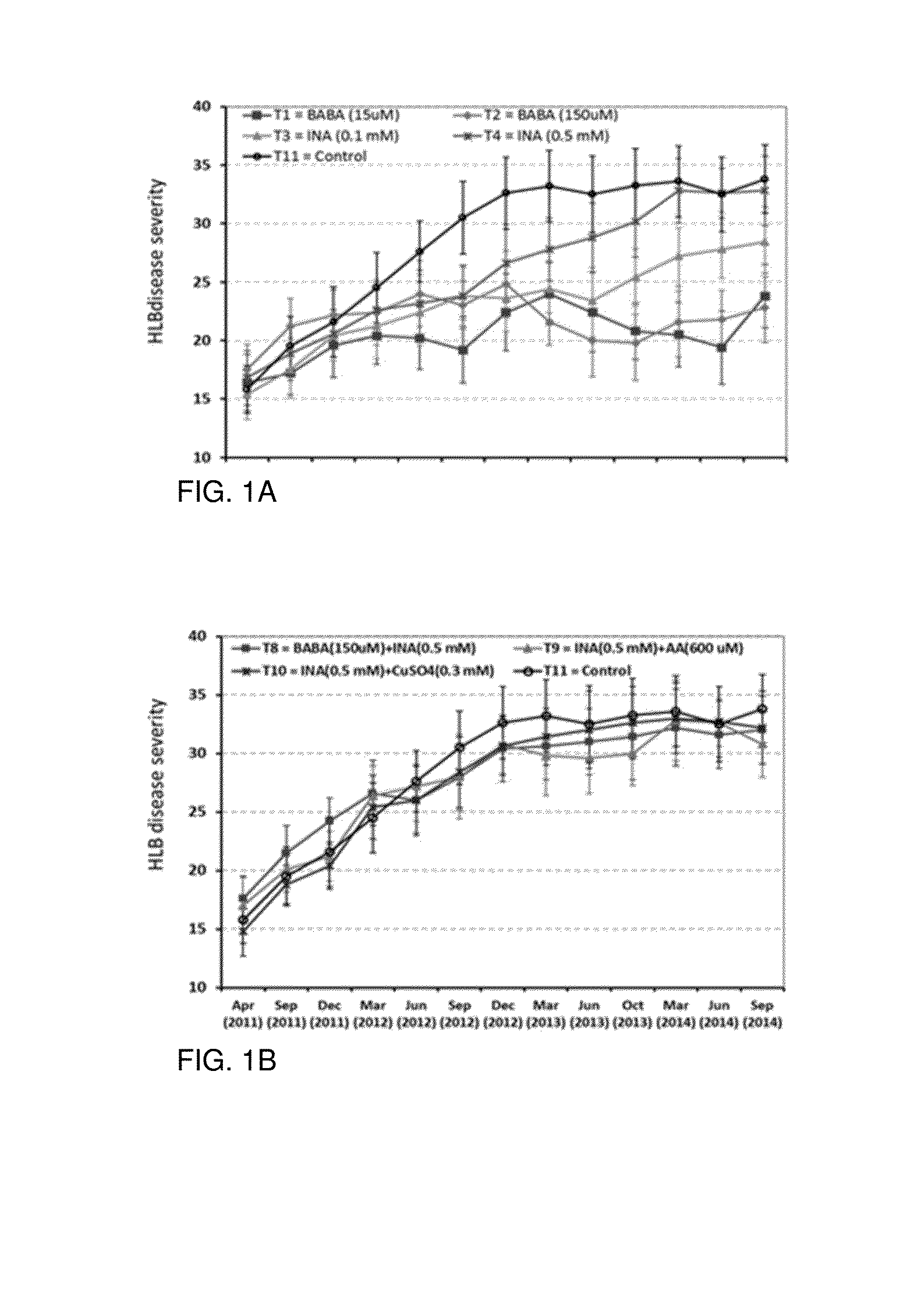Plant defense inducer compounds for citrus huanglongbing
a technology of plant defense and inducer compounds, which is applied in the field of compositions and compounds of plant defense inducers, can solve the problems of not excluding other possible time periods, las is incapable of metabolizing 2-ddg, and 2-ddg might hamper las cell growth, so as to improve crop productivity and crop quality of citrus plants, reducing crop yield, and increasing juice conten
- Summary
- Abstract
- Description
- Claims
- Application Information
AI Technical Summary
Benefits of technology
Problems solved by technology
Method used
Image
Examples
example 1
A. General Methods
[0109]SA, BTH, and INA have low solubility in water and therefore were first dissolved in ethanol and the dissolved solutions were further diluted to desired concentrations with water. Surfactants, emulsifiers and penetrants also optionally can be added to enhance absorption of the compounds. The remaining compounds are water soluble and were dissolved in water to the desired concentration for use.
B. Disease Severity Analysis
[0110]To estimate disease severity, the method described by Gottwald et al., 2007 (visual assessment) was applied. Briefly, each tree was divided into eight sections, i.e., an upper and lower hemisphere, and each hemisphere was subdivided into four equal sections. Then, each section was scored individually on a 0 to 5 scale that indicates the proportion of limbs expressing HLB symptoms within each section (0=no limbs; 1=1-20% limbs; 2=20-40% limbs; 3=40-60% limbs; 4=60-80% limbs; and 5=80-100% limbs). This resulted in an ove...
example 2
Initial Field Trials Using Trunk Injection
[0116]The chemical inducers salicylic acid (SA), oxalic acid (OA), potassium phosphate dibasic (PPD), acibenzolar-S-methyl (ASM; Actigard®, Syngenta, 50 WP), imidacloprid (ICD; AmTide® imidacloprid 2F, AmTide® LLC, CA), L-Ascorbic acid sodium salt (AA; 500GR), DL-2-aminobutyric acid (BABA), 2,1,3-benzothiadiazole (BTH), and 2,6-dichloro-isonicotinic acid (INA) were injected into the trunks of trees. The antibiotic oxytetracycline (OTC, Arbor-OTC™ formulation, Arborjet Inc. MA) was included as positive control. Trees used as negative controls were injected with water and are indicated as “CK” in FIGS. 4A-1A and 4B-1B.
[0117]Trunk injection of chemical inducers was carried out during a warm and sunny day. Two holes per tree were made on the main stem 30 cm directly above root flares to facilitate best uptake and canopy distribution. Holes were drilled to a depth of 2-3 cm using a 7.14 mm ( 9 / 32″) drill bit. A no. 3 Arborplug® was set into each ...
example 3
MidFlorida Foundation Grove, Trial I
[0120]This trial was conducted in a block of 7-year-old Midsweet orange (Citrus sinensis (L.) Osbeck) on Carrizo citrange (Poncirus trifoliata (L.) Raf.×C. sinensis (L.) Osbeck.) rootstock, planted in MidFlorida Foundation grove, Florida, in 2004. The experimental design was a completely randomized design with 11 treatments, each consisting of 5 trees. Treatment applications were made every three or four months when flush was present, starting with the spring flush in April 2011. Individual trees were chosen for the experiment based upon the presence of the symptoms of HLB. An attempt was made to select trees in the same stage of HLB symptom expression; i.e., initial symptoms observed in less than 30% of the canopy. All trees selected for the experiment were confirmed to be HLB-positive via a real-time quantitative polymerase chain reaction (qPCR) assay (as described in Trivedi et al., 2009). See Example 1. All trees within the trial area were mai...
PUM
 Login to View More
Login to View More Abstract
Description
Claims
Application Information
 Login to View More
Login to View More - R&D
- Intellectual Property
- Life Sciences
- Materials
- Tech Scout
- Unparalleled Data Quality
- Higher Quality Content
- 60% Fewer Hallucinations
Browse by: Latest US Patents, China's latest patents, Technical Efficacy Thesaurus, Application Domain, Technology Topic, Popular Technical Reports.
© 2025 PatSnap. All rights reserved.Legal|Privacy policy|Modern Slavery Act Transparency Statement|Sitemap|About US| Contact US: help@patsnap.com



